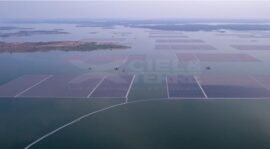Highlights :
The study examined grid stability with 100% WWS + storage in U.S. regions and states. And found that even with extreme weather, no blackouts occur in Texas, California, or any other state

Wind-Water and Solar (WWS) ensures grid stability and zero blackouts. A new study conducted by Mark Z. Jacobson and colleagues at Stanford University claimed this, as they analyzed grid stability in over 50 U.S States and District of Columbia. Jacobson is a Professor of civil and environmental engineering at Stanford.
The new research, an effort to mitigate concerns about stability of grids in a world completely powered by renewable energy, focused on 100% WWS powered grids across the areas under purview. It found no risk of blackouts in any region and associated benefits in terms of cost reduction, job creation and land use.
The study examined grid stability after all the States’ energy driven sectors (electricity, transportation, buildings, industry) transitioned to 100% clean WWS electricity and heat plus storage and demand response (thus to zero air pollution and zero carbon). Grid stability was analyzed in five regions; six isolated states (Texas, California, Florida, New York, Alaska, Hawaii); Texas interconnected with the Midwest, apart from other regions. The study says, no blackouts occur, including during summer in California or winter in Texas. The analysis of grid stability was done for over a period of 2050-2051.
Jacobson and some of his other colleagues had previously developed roadmaps for transitioning 139 countries to 100 % clean, renewable energy by 2050 with 80 % of that transition to be completed by 2030. The present study examines ways to keep the grid stable with these roadmaps in the backdrop.
As the world is actively target setting for achieving less carbon goals, and switching to 100% renewables, grid stability in case of 100 % renewable sources has been one of the issues of concern, because of myths attached to it. While across the world, renewable power is displacing traditional generation, yet there are doubts whether renewables also can replace the critical stability functions that go with it. NREL too had studied this aspect of grid stability in a study that was released in 2020.
NREL study had also confirmed that solar, wind, and hybrid power plants can provide their own source of grid stability—potentially unlike anything currently on the grid. The study claimed that it is a myth that renewable energy produces instability on electrical grids and that we need conventional generation to compensate it.
The Jacobson study also finds that no batteries with over 4-h storage are needed. Concatenating 4-h batteries provides long-duration storage. Whereas transitioning more than doubles electricity use, it reduces total end-use energy demand by ∼57% versus business-as-usual (BAU), contributing to the 63 (43–79)% and 86 (77–90)% lower annual private and social (private + health + climate) energy costs, respectively, than BAU.
Costs per unit energy in California, New York, and Texas are 11%, 21%, and 27% lower, respectively, and in Florida are 1.5% higher, when these states are interconnected regionally rather than islanded. Transitioning may create ∼4.7 million more permanent jobs than lost and requires only ∼0.29% and 0.55% of new U.S. land for footprint and spacing, respectively, less than the 1.3% occupied by the fossil industry today.
According to an International Energy Agency report, the renewable energy sector’s growth is set to skyrocket by a whopping 50% between 2019 and 2024. With solar photovoltaic energy leading the way, closely followed by wind and hydropower projects – which are gaining traction with speedy rollouts, the fastest observed in four years. This growth is happening because of the reduced costs of renewable energy technologies, global set targets and decarbonisation policies, and the increasingly high electricity demand.
Grid studies have advocated the case of RE variable in power systems. They have helped establish flexibility requirements of power systems and build confidence among investors and operators about increased variable RE levels in power system.





























